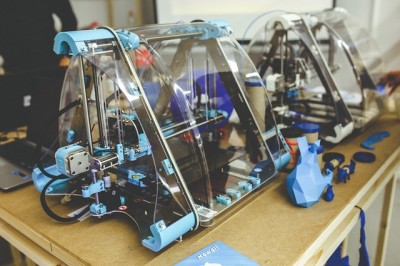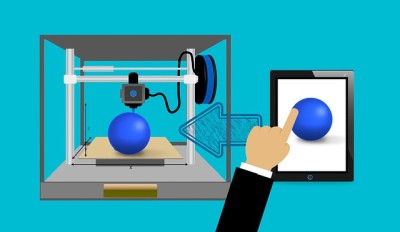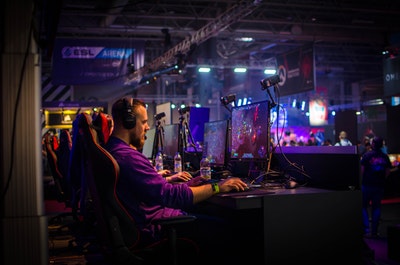3D Printers – How Do They Work?

What is 3D printing?
You’re probably familiar with the common household 2D printer, which works by injecting ink onto paper in the pattern of whatever is digitally sent to it, well, a 3D printer works in much the same way – picture a robotic hot glue gun that squirts plastic instead of glue and you’ll get the idea.
A 3D printer takes a 3D digital model and uses this to create an exact replica in whichever material it has been loaded with, most often a filament of plastic.
How does 3D printing work?
3D printing always begins with a 3D digital blueprint of the physical part or object.
These blueprints are often created in a CAD program such as TinkerCAD, Fusion360, or Sketchup but they can be created in other 3D software too.
3D printers may be clever but they still work with a 2D language and so a computer program is needed to then slice this digital 3D model into very thin 2D layers – these layers are what the 3D printer will then print onto the print platform.
Once the 3D model has been sliced and sent to the printer in a language that the printer can understand the printer will start by creating the bottom 2D layer, once this has completed it will work its way up, layer by layer until it has completed the 3D part or object.
If the part or object to be printed has a hollow centre then the slicing program will also handle the fill of the model, creating a lattice-like structure to give the model more stability.
The exact way that each 3D printer prints tends to vary by the make or model, for example, a desktop FDM printer will melt a plastic filament and lay it down onto the print platform through a nozzle, whereas larger industrial machines may use lasers to melt thin layers of plastic or plastic powders, but the basic principles are the same.
Various different types of plastics are by far the most common materials used with 3D printers as they can offer a number of different finishes, textures, and colors whilst also being relatively cheap to buy.
There are 3D printers out there that are able to work with other materials such as metal, and there are even 3D printers that are now working with fake meat and proteins and so it won’t be long until we see a more diverse array of 3D printed products.
With 3D printing technology advancing rapidly all of the time the versatility of 3D printers is continuously increasing and it is expected that we will be able to 3D print in virtually any material in the near future.

How long do 3D printers take?
Whereas a traditional 2D printer can print hundreds of pages in an hour, a 3D printer takes a comparatively long time to complete a project.
Depending on the size of the model and the type of printer used the printing process usually takes between 4 to 18 hours to complete and even once the print is complete there will be additional post-processing measures that will need to be taken before the item is finished.
Even with post-processing measures, 3D printing is still a far quicker production process than other manufacturing methods, especially those for individual parts or components.
What are the advantages and disadvantages of 3D printing?
3D printing provides an alternative method of creating parts or objects compared with the traditional subtractive or formative manufacturing technologies and as such, it comes with its own set of advantages and disadvantages as outlined below.
The advantages of 3D printing
- Lower start-up costs
Compared to the cost of creating a unique mould for a formative manufacturing process which can cost many thousands, 3D printing is extremely cheap, needing only the cost of the material printed and the time of the printer. This makes it a great alternative for people looking for lower-cost prototypes and unique one-off parts.
- Greater customization
There’s a reason why so many of the world’s products come in standard sizes and dimensions, exactly the reason stated above, creating unique molds can cost a lot of money and so to make the production process economical they must then create and sell many identical products to recoup the cost. 3D printing takes away this cost making it easier to customize products to meet an individual’s needs.
- Easier prototyping
One of the main uses of 3D printers is to create product prototypes. 3D printing has not only made this process cheaper but also quicker with many desktop 3D printers able to print a prototype overnight or at most within a day. This has dramatically sped up the creative process and enabled more people to pursue their innovations.
- Cheap creation of complex geometrical shapes
Creating a mould for a complicated geometric shape can be very costly. Thankfully, the addictive nature of 3D printing means that it is equipped to handle even the most complex geometric shapes at no extra cost to the manufacturer.
The disadvantages of 3D printing
- Lower tensile strength
Because of the materials used for 3D printing and the way in which the layers are laid on top of each other, most 3D printed models have up to 50% less tensile strength than models created using other manufacturing methods. This means that parts or objects created on 3D printers are mostly used for non-essential purposes. - Not cost-effective at higher volumes
3D printers may make creating a one-off or handful of products cheaper but when you reach around the 100 unit mark it can become more expensive than if you’d invested in a mold for a bulk processing technique such as injection molding. - 3D models often require support removal
Even 3D printers struggle to create complex structures in thin air which is why they build themselves supports to ensure the structure they print stays stable as they print. These supports must be removed as a part of the post-printing procedure and can leave blemishes on the final product.
What are 3D printers used for?
3D printing is extremely versatile and is widely used across many industries. Here are just 3 examples of places where 3D printing is being used.
- Healthcare
The customizable nature of 3D printing has made it a great tool for manufacturers within the healthcare sector. Almost all hearing aids in the US are created as a result of 3D printing and the prosthetic sector is beginning to use the technology to create prosthetic limbs too. One futuristic use of 3D printers could be to print organs using the patient’s own cells, reducing the time patients need to spend waiting for a donation. - Entertainment
Movie directors and set stylists love to use 3D printers to help them bring their creative ideas to life. 3D printers enable the entertainment industry to create lifelike props and sets at a considerably lower cost than before. - Automotive
Car manufacturers have been using 3D printers to create rapid prototypes of new parts for several years. 3D printing has helped to speed up the production process. - Architecture
3D printing has revolutionized architecture making it easier than ever to visualize a 3D model of a building. We may even see the first 3D printed life-size house in the next few years.
Can I buy a 3d printer?
The short answer is yes.
3D printers are now becoming quite widely available and the price of a 3D printer has dropped significantly in recent years meaning that you can own one of your own for as little as $300.






